
A pegmatite is an igneous rock showing a very coarse texture, with large interlocking crystals usually greater in size than 1 cm (0.4 in) and sometimes greater than 1 meter (3 ft). Most pegmatites are composed of quartz, feldspar, and mica, having a similar silicic composition to granite. However, rarer intermediate composition and mafic pegmatites are known.
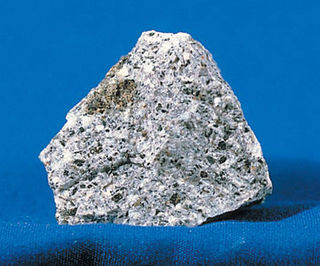
Syenite is a coarse-grained intrusive igneous rock with a general composition similar to that of granite, but deficient in quartz, which, if present at all, occurs in relatively small concentrations. It is considered a granitoid. Some syenites contain larger proportions of mafic components and smaller amounts of felsic material than most granites; those are classed as being of intermediate composition.

The rare-earth elements (REE), also called the rare-earth metals or rare-earths or, in context, rare-earth oxides, and sometimes the lanthanides, are a set of 17 nearly indistinguishable lustrous silvery-white soft heavy metals. Compounds containing rare-earths have diverse applications in electrical and electronic components, lasers, glass, magnetic materials, and industrial processes.
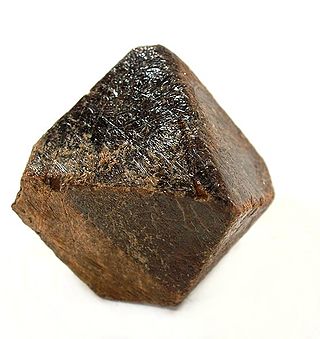
Pyrochlore2Nb2O6(OH,F) is a mineral group of the niobium end member of the pyrochlore supergroup. The general formula, A2B2O7, represent a family of phases isostructural to the mineral pyrochlore. Pyrochlores are an important class of materials in diverse technological applications such as luminescence, ionic conductivity, nuclear waste immobilization, high temperature thermal barrier coatings, automobile exhaust gas control, catalysts, solid oxide fuel cell, ionic/electrical conductors etc.

The mineral bastnäsite (or bastnaesite) is one of a family of three carbonate-fluoride minerals, which includes bastnäsite-(Ce) with a formula of (Ce, La)CO3F, bastnäsite-(La) with a formula of (La, Ce)CO3F, and bastnäsite-(Y) with a formula of (Y, Ce)CO3F. Some of the bastnäsites contain OH− instead of F− and receive the name of hydroxylbastnasite. Most bastnäsite is bastnäsite-(Ce), and cerium is by far the most common of the rare earths in this class of minerals. Bastnäsite and the phosphate mineral monazite are the two largest sources of cerium and other rare-earth elements.

Phonolite is an uncommon shallow intrusive or extrusive rock, of intermediate chemical composition between felsic and mafic, with texture ranging from aphanitic (fine-grained) to porphyritic. Phonolite is a variation of the igneous rock trachyte that contains nepheline or leucite rather than quartz. It has an unusually high Na2O + K2O content, defining its position in the TAS classification of igneous rocks. Its coarse grained (phaneritic) intrusive equivalent is nepheline syenite. Phonolite is typically fine grained and compact. The name phonolite comes from the Ancient Greek meaning "sounding stone" due to the metallic sound it produces if an unfractured plate is hit; hence, the English name clinkstone is given as a synonym.

Nepheline syenite is a holocrystalline plutonic rock that consists largely of nepheline and alkali feldspar. The rocks are mostly pale colored, grey or pink, and in general appearance they are not unlike granites, but dark green varieties are also known. Phonolite is the fine-grained extrusive equivalent.
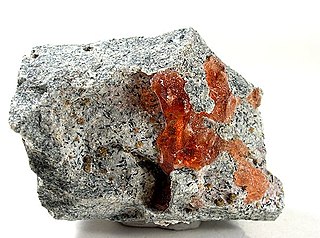
Villiaumite is a rare halide mineral composed of sodium fluoride, NaF. It is very soluble in water and some specimens fluoresce under long and short wave ultraviolet light. It has a Mohs hardness of 2.5 and is usually red, pink, or orange in color. It is toxic to humans.
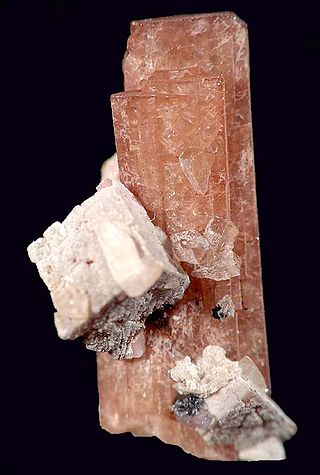
Nenadkevichite is a rare silicate mineral containing niobium with the chemical formula (Na,Ca)(Nb,Ti)Si2O7·2H2O. It forms brown to yellow to rose colored orthorhombic dipyramidal crystals with a dull to earthy luster. It has a Mohs hardness of 5 and a specific gravity of 2.86.

Uranium ore deposits are economically recoverable concentrations of uranium within the Earth's crust. Uranium is one of the most common elements in the Earth's crust, being 40 times more common than silver and 500 times more common than gold. It can be found almost everywhere in rock, soil, rivers, and oceans. The challenge for commercial uranium extraction is to find those areas where the concentrations are adequate to form an economically viable deposit. The primary use for uranium obtained from mining is in fuel for nuclear reactors.
The mineral industry of Russia is one of the world's leading mineral industries and accounts for a large percentage of the Commonwealth of Independent States' production of a range of mineral products, including metals, industrial minerals, and mineral fuels. In 2005, Russia ranked among the leading world producers or was a significant producer of a vast range of mineral commodities, including aluminum, arsenic, cement, copper, magnesium compounds and metals, nitrogen, palladium, silicon, nickel and vanadium.

The Ilimaussaq intrusive complex is a large alkalic layered intrusion located on the southwest coast of Greenland. It is Mesoproterozoic in age, about 1.16 Ga. It is the type locality of agpaitic nepheline syenite and hosts a variety of unusual rock types.
An agpaitic rock is a peralkaline igneous rock, typically nepheline syenite or phonolite. Characteristic minerals in these rocks include complex silicates containing zirconium, titanium, sodium, calcium, the rare-earth elements, and fluorine. Agpaites are unusually rich in rare and obscure minerals such as eudialyte, wöhlerite, loparite, astrophyllite, lorenzenite, catapleiite, lamprophyllite, and villiaumite (NaF). Sodalite is typically present, but not diagnostic. Less alkaline igneous rocks in which zircon, titanite, and ilmenite are characteristic are called miaskitic.

Stillwellite-(Ce) is a rare-earth boro-silicate mineral with chemical formula (Ce,La,Ca)BSiO5.

Tuperssuatsiaite is a rare clay mineral found in Greenland, Namibia and Brazil. It is a hydrated phyllosilicate of sodium and iron.
Thor Lake is a deposit of rare metals located in the Blachford Lake intrusive complex. It is situated 5 km north of the Hearne Channel of Great Slave Lake, Northwest Territories, Canada, approximately 100 kilometers east-southeast of the capital city of Yellowknife. Geologically located on the Canadian Shield it is mostly composed of peralkaline syenite. The Blatchford Lake complex was created in the early Proterozoic, 2.14 Ga ago. The deposit is divided in several sub-structures. In a small zone at the northern edge of the syenite, the T-Zone, minerals like bastnäsite, phenakite and xenotime can be found.
Energy Transition Minerals Ltd is an ASX-listed company focused on the exploration, development and financing of minerals that are critical to a low carbon future. The company’s current projects include the Kvanefjeld, located in Greenland, and Villasrubias, located in Spain.
Norra Kärr or Norra Kärr Alkaline Complex is an intrusive complex cropping out at the boundary between Östergötland and Småland, Sweden. The complex is chiefly made up of peralkaline nepheline syenite and is rich in exotic minerals. Rocks of the complex intruded into the Paleoproterozoic-aged Växjo granites of the Transscandinavian Igneous Belt. Alfred Elis Törnebohm was the first to describe the rocks of Norra Kärr in 1906. Norra Kärr was discovered a few years earlier during regional geological maping by the Swedish Geological Survey. The complex derives its name from a local farm, which translates into English as "Northern Fen". In 1968 Harry von Eckermann published his investigations on the complex defining its boundaries and confirming the view of it as an intrusion.
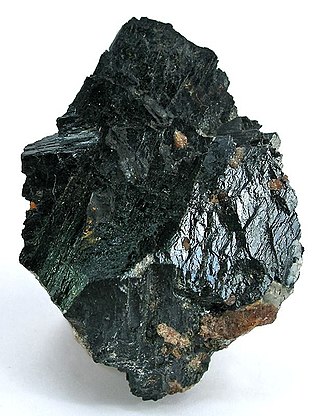
Britholite-(Ce) is a rare radioactive mineral with the chemical formula (Ce,Ca)5(SiO4)3OH. It comes in a variety of different colors. Its type locality is Naujakasik (Naajakasik), Tunulliarfik Fjord, Ilímaussaq complex, Narsaq, Kujalleq, Greenland.
Mariane Paviasen is a Greenlandic politician. She was elected to the Inatsisartut, the parliament of Greenland, during the 2021 general election. She is a member of the Inuit Ataqatigiit party and a vocal opponent to uranium mining.
















